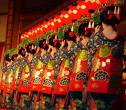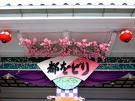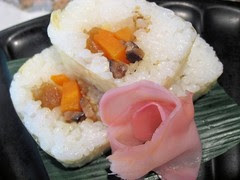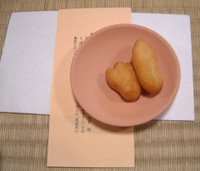:::::::::::::::::::::::::::::::::::::::::::::::::::::::::::::::::::::::::::::::::::::::::::::::::::
Saga 嵯峨 Spring Festivals
***** Location: Kyoto, Japan
***** Season: Various, see below
***** Category: Observance
*****************************
Explanation
Saga is an area in Kyoto, Arashiyama Saikyo-ku district.
京都市右京区の嵐山.
There are many large temples in the area, which was used by the courtiers as a retreat after leaving politics.
Daikakuji 大覚寺 Temple Daikaku-Ji
see below
Seiryooji 清涼寺 Temple Seiryo-Ji, Shakado 釈迦堂
see below
. Tenryuuji 天竜寺 - 天龍寺 Temple Tenryu-Ji .
Rinzai Zen Temple

Daruma painted by Seki Bokuoo (1903 - 1991)
関牧翁の筆
- Shared by Charlie Smith at Kyoto.
Joys of Japan, March 2012
Many festivals of these temples are kigo.
:::::::::::::::::::::::::::::::::::::::::::::::::::::::::::::::::::::::::::::::::::::::::::::::::::::
Emperor Saga
Emperor Saga (嵯峨天皇, Saga-tennō) (786–842)
was the 52nd emperor of Japan, according to the traditional order of succession. His reign spanned the years from 809 through 823.
Saga was a scholar of the Chinese classics. He was also a renowned as a skillful calligrapher.
According to legend,
he was the first Japanese emperor to drink tea.
Emperor Saga Tenno played an important role as a stalwart supporter of the Buddhist monk Kūkai Kobo Daishi. The emperor helped Kūkai to establish the Shingon School of Buddhism by granting him the Toji temple in the capital Heian-kyō (present day Kyoto).
Saga's grandson, Minamoto no Tōru, is thought to be an inspiration for the protagonist of the novel The Tale of Genji.
In ancient Japan, there were four noble clans, the Gempeitōkitsu (源平藤橘). One of these clans, the Minamoto clan are also known as Genji (源氏), and of these, the Saga Genji (嵯峨源氏) are descended from 52nd emperor Saga.
© More in the WIKIPEDIA !
. Saga Tenno 嵯峨天皇 and 弘法大師空海 Kukai Legends .
- 9 more legends to explore -
:::::::::::::::::::::::::::::::::::::::::::::::::::::::::::::::::::::::::::::::::::::::::::::::::::
kigo for mid-spring

Saga no hashira taimatsu
嵯峨の柱炬 (さがのはしらたいまつ)
Saga torch ceremony
..... Saga o-taimatsu 嵯峨御松明(さがおたいまつ)
..... hashira taimatsu 柱松明(はしらたいまつ)
..... o-taimatsu 御松明(おたいまつ)
In memory of the anniversary of Shakyamuni Buddha on March 15 at the temple Seiryo-Ji. (originally it was held on February 15.)
嵯峨御松明式
At about seven thirty at night, three torches of about seven meters length and 1.5 meters diameter are lit. From the power of the flames the good fortune and harvest of the coming year is divined.
One of the three famous fire festivals of Kyoto.
. . WKD : Fire Festivals of Japan
:::::::::::::::::::::::::::::::::::::::::::::::::::::::::::::::::::::::::::::::::::::::::::::::::::
kigo for late spring

Saga Dainenbutsu Kyoogen
嵯峨大念仏狂言(さがだいねんぶつきょうげん)
Amida Buddha Prayer Kyogen
..... Saga dainenbutsu 嵯峨大念仏 (さがのだいねんぶつ)
..... Saga nenbutsu 嵯峨念仏(さがねんぶつ)Saga nembutsu
One of the three most important prayer kyogen performances at the Shakado hall of temple Seiryo-Ji. This prayer ceremony is held in spring and autumn, but the spring one is the kigo.
It used to be on march 15, but now it is held for two days on a saturday and sunday in mid-april.
It was started by saint Engaku at temple Mibudera (Mibu Nenbutsu) in the year 1279., who prayed to see his deceased mother again.
It is now an intangible cultural folk property.
Like in the Mibu Nenbutsu, there are no words, but only the sound of the gong "kanden kanden" and the big drum. It is really quite a rural dance performance of Old Saga.
The various performances are called
Hana nusubito 花盗人
. . . CLICK here for Photos !
Daibutsu kuyoo 大仏供養
Yo-uchi Soga 夜討曽我
. . . CLICK here for Photos !
and others.
.................................................................................
Saga men 嵯峨面 masks from Saga

Fudo Myo-O in red 不動明王面(赤)
Look here for more from the Fujiwara family masks:
source : fujiwara/
Originally the masks from the Shakado Kyogen were produced from papermachee and sold at the temple as amulets for the visitors. This custom was abolished during the Meiji period.
Now it has been picked up again by Fujiwara Fuseki 藤原孚石.
His son and grandson are now producing these simple, but charming masks.
They are made by plastering washi paper into the mold, then taking the mask out and coloring it. This is now the job of the second generation Fuseki. His son still has to learn how to plaster the masks.
The paper is taken from old books, since this is the strongest washi. He uses pages with Hiragana for female masks and pages with Kanji for male masks.
There are now about 30 different kinds made by the Fujiware family.

CLICK for more photos !
. Masks from Japan .
.................................................................................
. . WKD : Namu Amida Butsu, the Amida Prayer
. . WKD : Kyogen, kyoogen 狂言 and Haiku
:::::::::::::::::::::::::::::::::::::::::::::::::::::::::::::::::::::::::::::::::::::::::::::::::::::
External LINKS
The Living Buddha – Seiryoji Temple, Kyoto
http://www.japannavigator.com/2007/04/13/the-living-buddha-seiryoji-temple-kyoto/
*****************************
Worldwide use
*****************************
Things found on the way
. WASHOKU
厄落としの大根焚き(お会式)Daikotaki
Cooking Radishes for Nichiren
at Temple Sanpo-Ji 三寳寺 (さんぽうじ)
with tofu from Saga 嵯峨豆腐.
Sagadoofu is the starting point of Kyoto Tofu, with its beans from the Saga plain and fresh water from the nearby forests.
mukashidoofu むかし豆腐 old-fashioned tofu (touhu)
Made by the shop Morika 森嘉(もりか)near Shakado Hall (Seiryo-ji Temple).
It is made with sumashi-ko すまし粉), sekko, a kind of calcium sulfate instead of nigari. This dates back to a time after the war when they could not get any real nigari and had to find a substitute.
The store uses only the old equipment and all is made by hand. Only a small amount of this tofu is made every day for sale.
Kawabata Yasunari was fond of this hard tofu.
. . . CLICK here for Photos !
Morika no karashidoofu からし豆腐 tofu with mustard flavor
. WASHOKU
Famous Dishes from Kyoto

松明の火の粉映して嵯峨豆腐
taimatsu no hi no ko terashite Sagadoofu
light up by the sparks
from the huge torch ...
tofu from Saga
Shimaoka Kaihyoo 島岡海豹
http://web.kyoto-inet.or.jp/people/morig191/haiku.html
.................................................................................
浅春の井水溢らせ嵯峨豆腐
senshun no seisui afurase Sagadoofu
overflowing with
well water from early spring ...
tofu from Saga
Hiko ヒコ
http://nashi.shashin-haiku.jp/node/71915

Daruma on a lantern at a shop in Saga
. WASHOKU
aburimochi, aburi mochi あぶりもち. のあぶり餅
slightly roasted dumplings
from Saga, Kyoto
*****************************
HAIKU
いざのぼれ嵯峨の鮎食ひに都鳥
iza nobore Saga no ayu kui ni miyakodori
Let's go up to Saga,
You seagulls,
And eat trout!
Yasuhara Teishitsu 安原貞室 (1610-73)
Tr. Blyth
:::::::::::::::::::::::::::::::::::::::::::::::::::::::::::::::::::::::::::::::::::::::::::::::::::
Seiryooji 清涼寺 Temple Seiryo-Ji
Shakado 釈迦堂 The Shaka Hall
行秋やすでに御釈迦は京の空
yuku aki ya sude ni o-shaka wa kyoo no sora
autumn ends--
already the Buddha
fills Kyoto's sky
Tr. David Lanoue
or
autumn ends--
already the statue of Buddha Shakyamuni
is under the sky of Kyoto
Tr. Gabi Greve
In a prescript to this haiku, Kobayashi Issa alludes to a statue of Gautama Buddha being returned to its temple in Kyoto.
Seiryooji 清涼寺 Temple Seiryo-Ji in Saga, Kyoto, is quite famous for the sandalwood statue of Gautama Shakyamuni which is about 160 cm high and rather simple in a robe of Indian style of Gandhara Buddhas. It was made in China and had the intestines made of silk inside.

The statue had been shown at the temple Eko-In 回向院 (Ekooin) in Edo in 1810.
By using the expression sude ni Issa shows us that the Buddha statue is already back home, while he is still in Edo, trying to get his inheritage, to get back under his own sky in Shinano.
In 538 the very first Buddha image to arrive in Japan was a statue of Shakyamuni presented as a gift by a Korean king.
... in 1249 the priest Eison ordered a copy of the Seiryoji Shaka and installed it as the principal object of worship at the large Saidaiji temple in Nara.
... The Seiryoji Shaka is still shown on the 8th of each month.
source : www.taleofgenji.org
Seiryōjishiki Shaka 清凉寺式釈迦
LEGEND ABOUT SEIRYOUJI STATUE.
LEGEND ABOUT “UDAYANA” STATUE.
source : - Mark Schumacher -
. Tainai Butsu 胎内佛, 胎内仏 statue within the statue .
quote
Shaka Nyorai (Shakyamuni, Gautama Siddharta)
Die Verkörperung des Prinzen Shakyamuni Gautama (um 550 - 480), geboren in Kapila, Indien, der als Mensch tatsächlich gelebt, die Erleuchtung erlangt und diese Lehre dann verbreitet hat. Als Figuren des Religionsgründers waren Shaka-Statuen in der Asuka-Zeit in Japan zunächst besonders beliebt. Älteste Statuen in Indien aus Gandhara und Madura, um 100 v.Chr., in Japan aus der Asuka-Zeit, z.B. Shaka-Statue des Udenoo des Tempels Seiryooji in Kyooto mit fast noch indischem Faltenwurf.
Shaka-Statue des Udenoo
(Udenoo (Utenoo) Shaka, Zuizoo Shaka)
König Udayana (Udenoo, Utenoo) von Kausambii in Indien war ein Gläubiger, dessen Leben im Sutra Zooitsu Agonkyoo beschrieben wird. Nachdem Shakyamuni in den Tushita-Himmel einging, wurde der König sehr krank. Seine Minister waren sehr besorgt und fertigten einen Buddhastatue aus Sandelholz; daraufhin wurde der König wieder gesund. Diese Statue, angeblich die erste Buddhastatue überhaupt, heißt auch "Glückverheißender Shaka" (Zuizoo Shaka).
Der japanische Priester Choonen ließ eine Kopie dieser Statue anfertigen und brachte diese "durch drei Länder" (Indien, China, Japan) gewanderte Figur mit nach Japan (sangoku denrai). Diese Kopie existiert heute noch im Tempel Seiryooji in Saga, Kyoto. Figuren in diesem fremdartig anmutenden Stil werden Seiryoo-Figuren (Seiryooshiki) oder Saga-Figuren (Sagashiki) genannt.
Die Haare des Shaka sind dabei wie ein dicker Zopf um den Kopf gerollt. Diese Statuen waren in der Kamakura-Zeit sehr beliebt; es soll insgesamt in den großen Tempeln des Landes über 100 Stück davon gegeben haben.
Udenoo ist auch bekannt als einer der Gefährten des Monju in der Monju-Fünfergruppe.
- Buddhastatuen ... Who is Who
Ein Wegweiser zur Ikonografie
von japanischen Buddhastatuen
Gabi Greve, 1994
.................................................................................

Temple Seiryo-Ji is famous for the plum blossoms and early red momiji leaves.
source : niwa/seiryoji.htm

source : www.taleofgenji.org
Shakado in Autumn splendor

. Yuugiri Ki 夕霧忌 Yugiri Memorial Day .
A memorial service for Yugiri Tayu is held every November at Seiryoji Temple.
She was a high-ranking courtesan at the Shimabara quarters in Kyoto.
kigo for early spring
.................................................................................
O-Mi-Nugui 御身拭
ritual cleansing of the Amida Buddha statue
on April 19
A statue of Amida Nyorai is shown and special prayer chantings (insei nenbutsu 引声念仏) performed.
The statue is then clensed with a white cloth dipped in fragrant water. This white cloth, when used to cover a dead body, makes sure the soul will go straight to Buddha's paradise in the West.
This ritual is in memory of the Mother of Anki Monin 安喜門院 (1207 - 1286), wife of Emperor Gohorikawa Tenno 後堀河天皇.
observance kigo for late spring

御僧のその手嗅(かぎ)たや御身拭
gosoo no sono te kagita ya ominugui
the smell of the hands
of the honorable priests -
cleaning the statue
Tr. Gabi Greve
or
go-soo no so no te kagita ya omi-nugui
I want to smell the hands
of the honorable priest--
cleaning the Buddha statue.
Tr. Naotaka Uematsu
. Tan Taigi 炭太祇 .
. OBSERVANCES – SPRING SAIJIKI .
Ritual cleaning (Ominugui) of statues is also done at other tempels at other times.
- Reference -
:::::::::::::::::::::::::::::::::::::::::::::::::::::::::::::::::::::::::::::::::::::::::::::::::::
Daikakuji Dainichi E 大覚寺大日会
Ceremony for Dainichi Nyorai
at Temple Daikaku-Ji
At the Dainichi Hall of the Octagonal Hall
八角堂の大日堂の祭り
28 of October
observance kigo for late autumn
. Dainichi Nyorai 大日如来 .
quote
Daikaku-ji is a Shingon temple dating from the Heian period. It is famous for moon-viewing boat cruises on Lake Ōsawa. Shakyō (sutra transcription) lessons are held daily at the temple.
Daikaku-ji was founded in 876 by Empress Masako (810-879) on the site of the Saga-rikyū, a country villa built for her father, Emperor Saga Tenno (786-842). The temple kept a close relation with the Imperial family, and was actually a monzeki (門跡), i.e. a temple whose appointed abbot was an Imperial prince.
In the early 14th century, retired Emperor Go-Uda (1267-1324) conducted his cloistered rule from Daikaku-ji. A school of ikebana named after the emepror, the Saga Goryū, is still based in the temple.

The Shin-den Hall (宸殿) was transported from its original location in the Imperial Palace in the 16th century. It contains some valuable fusuma screens attributed to the Sengoku-period Kanō school, the most famous schools of Japanese painting.
source : japan-guide
- quote
Daikaku-ji (大覚寺 Daikaku-ji is a Shingon Buddhist temple in Ukyō-ku, a western ward in the city of Kyoto, Japan. The main images are of the Five Wisdom Kings, centered on Fudō. It was a villa of Emperor Saga (785-842), and later, retired Emperor Go-Uda conducted his cloistered rule from here. A school of ikebana, the Saga Goryū, maintains its headquarters in the temple. The artificial lake of the temple, Osawa pond, is one of the oldest Japanese garden ponds to survive from the Heian Period
© More in the WIKIPEDIA !
There are moonviewing parties on boat on the Osawa pond.

Fudo Myo-O as venerated in the Hall of the 5 Great Fudo
五大堂, now in the Museum of the temple.
. Fudō Myō-ō, Fudoo Myoo-Oo 不動明王 Fudo Myo-O
Acala Vidyârâja - Vidyaraja .


- Homepage of the temple - Daikaku-Ji Monseki 大覚寺門跡
- source : www.daikakuji.or.jp
The temple is also famous for its Chrysanthemums

Saga-giku 嵯峨菊
- source : ichinen-fourseasonsinjapan.
People learn how to grow them to have flowers in the numbers of shichi-go-san
three on top, five in the middle and 7 near the bottom.
Also some withered leaves near the ground - and all this at the same time.
It is a secret to study how to grow them - only at this temple.
:::::::::::::::::::::::::::::::::::::::::::::::::::::::::::::::::::::::::::::::::::::::::::::::::::::

涼しさを絵にうつしけり嵯峨の竹
suzushisa o e ni utsushi keri Saga no take
coolness
portrayed in painting:
bamboos of Saga
Tr. Barnhill
Coolness.
Painted into a picture;
Bamboos of Saga.
Tr. Blyth
la fraîcheur peinte
dans une peinture ;
les bambous de Saga
Tr. Daniel Py
Matsuo Basho 松尾芭蕉
元禄7年 - 1694
Basho was staying at the home of Yamei 野明亭, a friend of Kyorai.
. Sakai Yamei (1662-1713) .
. Mukai Kyorai 向井去来 .
. Matsuo Basho 松尾芭蕉 - Archives of the WKD .
*****************************
Related words
***** Mibu Nenbutsu 壬生念仏
Invoction of Amida at Mibu Temple
Mibu Kyoogen 壬生狂言(みぶきょうげん)
***** Kyoto
. "capital of blossoms", hana no miyako 花の都 .
:::::::::::::::::::::::::::::::::::::::::::::::::::::::::::::::::::::::::::::::::::::::::::::::::::::
. Arashiyama 嵐山 Storm Mountain .
[ . BACK to WORLDKIGO . TOP . ]
[ . BACK to DARUMA MUSEUM TOP . ]
:::::::::::::::::::::::::::::::::::::::::::::::::::::::::::::::::::::::::::::::::::::::::::::::::::::







































